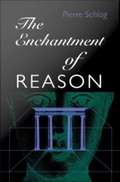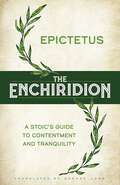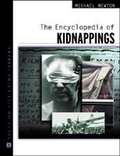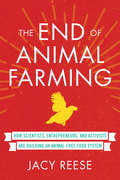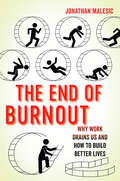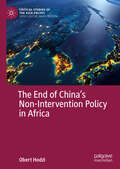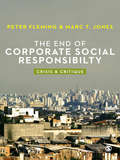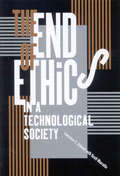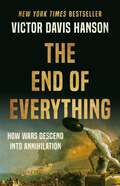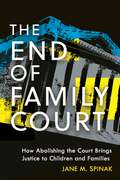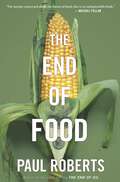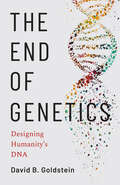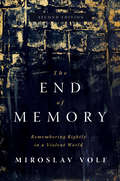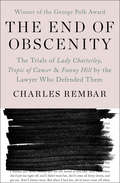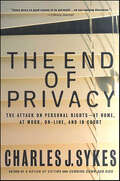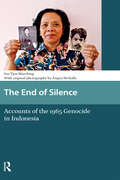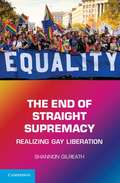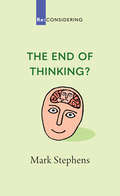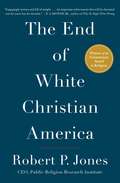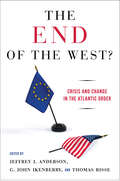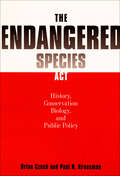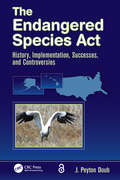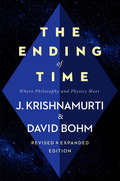- Table View
- List View
The Enchantment of Reason
by Pierre SchlagThe Enchantment of Reason is a lively critique of American legal thought and the American legal system's deification of reason. In an attempt to understand the current malaise of American law and the depressed condition of American intellectual life in general, Pierre Schlag diagnoses what he believes is an epidemic of pathological reliance on the principle of reason. Contending that legal thinkers continually fail to recognize the aesthetic and ethical prejudices of rationalism, Schlag creates a genealogy that shows how the call to reason has become a manipulative vehicle of power, faith, and prejudice. In examining the fierce resistance to questioning reason's primacy, this renowned critic and professor of American law demonstrates how those who use and study the law perpetuate their own methodological blind spots. Claiming that reason has been endowed with a virtually mystical power to organize social life, Schlag unravels the seemingly rational world of judicial opinions, statutes, doctrines, and legal principles. In the process, he paints a shocking--and sure to be controversial--picture of the chaos and, indeed, violence of the American legal tradition. This bold commentary on the irrationality of reason in American law and legal studies will interest not only legal scholars and philosophers but also serious thinkers across a broad disciplinary spectrum.
The Enchiridion: A Stoic's Guide to Contentment and Tranquility
by EpictetusThis lovely hardcover keepsake offers the timeless precepts of one of the most important Greek Stoic philosophers. Epictetus (ca. 50–ca. 130 CE) was born into slavery and had a permanent physical disability. After attaining his freedom, Epictetus spent his career teaching philosophy and advising a daily regimen of self-examination. His pupil Arrian later collected and published the master’s lecture notes as The Enchiridion, or Manual. Full of practical advice, this volume offers guidance for those seeking contentment, happiness, and tranquility in the modern world. Through the principles found in The Enchiridion, we learn that true freedom can be achieved by taking control of our thoughts and actions through self-awareness rather than trying to change events beyond our power. This enduring counsel on how to live follows maxims that have set generations of readers on the path to happiness and makes a wonderful gift for any occasion.
The Encyclopedia of Kidnappings
by Michael NewtonAn A-to-Z encyclopedia of kidnappings that have taken place throughout history, from Viking raids and Aztec sacrifices to modern-day political kidnappings. Alphabetically arranged by subject, organization, and victims' and kidnappers' names, the volume contains nearly 1,000 entries.
The End of Animal Farming: How Scientists, Entrepreneurs, and Activists Are Building an Animal-Free Food System
by Jacy ReeseA bold yet realistic vision of how technology and social change are creating a food system in which we no longer use animals to produce meat, dairy, or eggsMichael Pollan's The Omnivore's Dilemma and Jonathan Safran Foer's Eating Animals brought widespread attention to the disturbing realities of factory farming. The End of Animal Farming pushes this conversation forward by outlining a strategic roadmap to a humane, ethical, and efficient food system in which slaughterhouses are obsolete--where the tastes of even the most die-hard meat eater are satisfied by innovative food technologies like cultured meats and plant-based protein. Social scientist and animal advocate Jacy Reese analyzes the social forces leading us toward the downfall of animal agriculture, the technology making this change possible for the meat-hungry public, and the activism driving consumer demand for plant-based and cultured foods. Reese contextualizes the issue of factory farming--the inhumane system of industrial farming that 95 percent of farmed animals endure--as part of humanity's expanding moral circle. Humanity increasingly treats nonhuman animals, from household pets to orca whales, with respect and kindness, and Reese argues that farmed animals are the next step. Reese applies an analytical lens of "effective altruism," the burgeoning philosophy of using evidence-based research to maximize one's positive impact in the world, in order to better understand which strategies can help expand the moral circle now and in the future. The End of Animal Farming is not a scolding treatise or a prescription for an ascetic diet. Reese invites readers--vegan and non-vegan--to consider one of the most important and transformational social movements of the coming decades.
The End of Burnout: Why Work Drains Us and How to Build Better Lives
by Jonathan MalesicGoing beyond the how and why of burnout, a former tenured professor combines academic methods and first-person experience to propose new ways for resisting our cultural obsession with work and transforming our vision of human flourishing. Burnout has become our go-to term for talking about the pressure and dissatisfaction we experience at work. But because we don’t really understand what burnout means, the discourse does little to help workers who are suffering from exhaustion and despair. Jonathan Malesic was one of those workers, and to escape he quit his job as a tenured professor. In The End of Burnout, he dives into the history and psychology of burnout, traces the origin of the high ideals we bring to our dismal jobs, and profiles the individuals and communities who are already resisting our cultural commitment to constant work. In The End of Burnout, Malesic traces his own history as someone who burned out of a tenured job to frame this rigorous investigation of how and why so many of us feel worn out, alienated, and useless in our work. Through research on the science, culture, and philosophy of burnout, Malesic explores the gap between our vocation and our jobs, and between the ideals we have for work and the reality of what we have to do. He eschews the usual prevailing wisdom in confronting burnout ("Learn to say no!" "Practice mindfulness!") to examine how our jobs have been constructed as a symbol of our value and our total identity. Beyond looking at what drives burnout—unfairness, a lack of autonomy, a breakdown of community, mismatches of values—this book spotlights groups that are addressing these failures of ethics. We can look to communities of monks, employees of a Dallas nonprofit, intense hobbyists, and artists with disabilities to see the possibilities for resisting a "total work" environment and the paths to recognizing the dignity of workers and nonworkers alike. In this critical yet deeply humane book, Malesic offers the vocabulary we need to recognize burnout, overcome burnout culture, and find moral significance in our lives beyond work.
The End of China’s Non-Intervention Policy in Africa (Critical Studies of the Asia-Pacific)
by Obert HodziThis book gives a compelling analysis and explanation of shifts in China’s non-intervention policy in Africa. Systematically connecting the neoclassical realist theoretical logic with an empirical analysis of China’s intervention in African civil wars, the volume highlights a methodical interlink between theoretical and empirical analysis that takes into consideration the changing status of rising powers in the global system and its effect on their intervention behaviour. Based on field research and expert interviews, it provides a rigorous analysis of China’s emergent intervention behaviour in some key African conflicts in Libya, South Sudan and Mali and broadens the study of external interventions in civil wars to include the intervention behaviour of non-Western rising powers.
The End of Corporate Social Responsibility: Crisis and Critique
by Peter Fleming Marc V. JonesProviding a much-needed critique of Corporate Social Responsibility (CSR) practice and scholarship, this book seeks to redress CSR advocacy, from a political and critical perspective. <P><P> A strident approach backed up by extensive use of case studies presents the argument that most CSR-related activity aims to gain legitimacy from consumers and employees, and therefore furthers the exploitative and colonizing agenda of the corporation. By examining CSR in the context of the political economy of late capitalism, the book puts the emphasis back on the fact that most large corporations are fundamentally driven by profit maximization, making CSR initiatives merely another means to this end. Rather than undermining or challenging unsustainable corporate practices CSR is exposed as an ideological practice that actually upholds the prominence of such practices. <P> As CSR gathers momentum in management practice and scholarship, students in the fields of CSR, business ethics, and strategy, will find this text a useful companion to counter received wisdom in this area.
The End of Ethics in a Technological Society
by Lawrence E. Schmidt Scott MarrattoLawrence Schmidt and Scott Marratto challenge modern liberal ethics, arguing that there is no consistent ethical framework to deal with the long-range negative consequences of certain technological developments They examine established ethical approaches to such urgent contemporary concerns as environmental degradation, nuclear energy, high tech militarism, and fetal genetic testing, showing that the prevailing viewpoint valorizes autonomy above all other goods and considers technological advances as mere extensions of the range of human freedoms. Modern ethics thus fails to take into account the moral intuition that some possibilities in the realm of techno science simply ought not to be pursued. A comprehensive assessment of modern western society's commitment to technological progress, The End of Ethics in a Technological Society presents a convincing argument in favour of a post-liberal approach - one that rejects the ideology of progress, supports caution, and accepts limitation."
The End of Everything: How Wars Descend into Annihilation
by Victor Davis HansonAn instant New York Times bestseller, this &“profound book&” (Wall Street Journal) charts how and why some societies chose to utterly destroy their foes, and warns that similar wars of obliteration are possible in our time War can settle disputes, topple tyrants, and bend the trajectory of civilization—sometimes to the breaking point. From Troy to Hiroshima, moments when war has ended in utter annihilation have reverberated through the centuries, signaling the end of political systems, cultures, and epochs. Though much has changed over the millennia, human nature remains the same. Modern societies are not immune from the horror of a war of extinction. In The End of Everything, military historian Victor Davis Hanson narrates a series of sieges and sackings that span the age of antiquity to the conquest of the New World to show how societies descend into barbarism and obliteration. In the stories of Thebes, Carthage, Constantinople, and Tenochtitlan, he depicts war&’s drama, violence, and folly. Highlighting the naivete that plagued the vanquished and the wrath that justified mass slaughter, Hanson delivers a sobering call to contemporary readers to heed the lessons of obliteration lest we blunder into catastrophe once again.
The End of Family Court: How Abolishing the Court Brings Justice to Children and Families (Families, Law, and Society)
by Jane M. SpinakExplores the failures of family court and calls for immediate and permanent changeAt the turn of the twentieth century, American social reformers created the first juvenile court. They imagined a therapeutic court where informality, specially trained public servants, and a kindly, all-knowing judge would assist children and families. But the dream of a benevolent means of judicial problem-solving was never realized. A century later, children and families continue to be failed by this deeply flawed court.The End of Family Court rejects the foundational premise that family court can do good when intervening in family life and challenges its endless reinvention to survive. Jane M. Spinak illustrates how the procedures and policies of modern family court are deeply entwined in a heritage of racism, a profound disdain for poverty, and assimilationist norms intent on fixing children and families who are different. And the court’s interventionist goals remain steeped in an approach to equity and well-being that demands individual rather than collective responsibility for the security and welfare of families.Spinak proposes concrete steps toward abolishing the court: shifting most family supports out of the court’s sphere, vastly reducing the types and number of matters that need court intervention, and ensuring that any case that requires legal adjudication has the due process protections of a court of law. She calls for strategies that center trusting and respecting the abilities of communities to create and sustain meaningful solutions for families. An abolitionist approach, in turn, celebrates a radical imagination that embraces and supports all families in a fair and equal economic and political democracy.
The End of Food
by Paul RobertsPaul Roberts, the best-selling author of The End of Oil, turns his attention to the modern food economy and finds that the system entrusted to meet our most basic need is failing. In this carefully researched, vivid narrative, Roberts lays out the stark economic realities behind modern food and shows how our system of making, marketing, and moving what we eat is growing less and less compatible with the billions of consumers that system was built to serve. At the heart of The End of Food is a grim paradox: the rise of large-scale food production, though it generates more food more cheaply than at any time in history, has reached a point of dangerously diminishing returns. Our high-volume factory systems are creating new risks for food-borne illness, from E. coli to avian flu. Our high-yield crops and livestock generate grain, vegetables, and meat of declining nutritional quality. While nearly one billion people worldwide are overweight or obese, the same number of people—one in every seven of us—can&’t get enough to eat. In some of the hardest-hit regions, such as sub-Saharan Africa, the lack of a single nutrient, vitamin A, has left more than five million children permanently blind. Meanwhile, the shift to heavily mechanized, chemically intensive farming has so compromised soil and water that it&’s unclear how long such output can be maintained. And just as we&’ve begun to understand the limits of our abundance, the burgeoning economies of Asia, with their rising middle classes, are adopting Western-style, meat-heavy diets, putting new demands on global food supplies. Comprehensive in scope and full of fresh insights, The End of Food presents a lucid, stark vision of the future. It is a call for us to make crucial decisions to help us survive the demise of food production as we know it. Paul Roberts is the author of The End of Oil, which was a finalist for the New York Public Library's Helen Bernstein Book Award in 2005. He has written about resource economics and politics for numerous publications, including the Los Angeles Times, the Washington Post, Harper&’s Magazine, and Rolling Stone, and lectures frequently on business and environmental issues.
The End of Genetics: Designing Humanity's DNA
by David B. GoldsteinAn urgent plea for a broader understanding and awareness of the unconsidered dangers of new genetic technologies Since 2010 it has been possible to determine a person&’s genetic makeup in a matter of days at an accessible cost for many millions of people. Along with this technological breakthrough there has emerged a movement to use this information to help prospective parents &“eliminate preventable genetic disease.&” As the prospect of systematically excluding the appearance of unwanted mutations in our children comes within reach, David B. Goldstein examines the possible consequences from these types of choices. Engaging and accessible, this clarion call for responsible and informed stewardship of the human genome provides an overview of what we do and do not know about human genetics and looks at some of the complex, yet largely unexplored, issues we must be most careful about as we move into an era of increasing numbers of parents exercising direct control over the genomes of their children.
The End of Memory: Remembering Rightly in a Violent World
by Miroslav VolfWinner of the Christianity Today Book Award in Christianity and Culture How should we remember atrocities? Should we ever forgive abusers? Can we not hope for final reconciliation, even if it means redeemed victims and perpetrators spending eternity together? We live in an age that insists that past wrongs—genocides, terrorist attacks, bald personal injustices—should never be forgotten. But Miroslav Volf here proposes the radical idea that letting go of such memories—after a certain point and under certain conditions—may actually be a gift of grace we should embrace. Volf&’s personal stories of persecution and interrogation frame his search for theological resources to make memories a wellspring of healing rather than a source of deepening pain and animosity. Controversial, thoughtful, and incisively reasoned, The End of Memory begins a conversation that we avoid to our great detriment. This second edition includes an appendix on the memories of perpetrators as well as victims, a response to critics, and a James K. A. Smith interview with Volf about the nature and function of memory in the Christian life.
The End of Obscenity: The Trials of Lady Chatterley, Tropic of Cancer & Fanny Hill by the Lawyer Who Defended Them
by Charles RembarWinner of the George Polk Award: Charles Rembar's illuminating account of overturning America's obscenity laws and protecting literature from censorship Up until the 1960s, depending on your state of residence, your copy of Henry Miller's Tropic of Cancer might be seized by the US Postal Service before reaching your mailbox. Selling copies of Cleland's Fanny Hill in your bookstore was considered illegal. Lady Chatterley's Lover by D. H. Lawrence was, according to the American legal system, pornography with no redeeming social value. Today, these novels are celebrated for their literary and historic worth. The End of Obscenity is Charles Rembar's account of successfully arguing the merits of such great works of literature in front of the Supreme Court. As the lead attorney on the case, he--with the support of a few brave publishers--changed the way Americans read and honor books, especially the controversial ones. Filled with insight from lawyers, justices, and the authors themselves, The End of Obscenity is a lively tour de force. Racy testimony and hilarious asides make Rembar's memoir not only a page-turner but also an enlightening look at the American legal system.
The End of Ownership: Personal Property in the Digital Economy (The Information Society Series)
by Aaron Perzanowski Jason SchultzAn argument for retaining the notion of personal property in the products we “buy” in the digital marketplace. If you buy a book at the bookstore, you own it. You can take it home, scribble in the margins, put in on the shelf, lend it to a friend, sell it at a garage sale. But is the same thing true for the ebooks or other digital goods you buy? Retailers and copyright holders argue that you don't own those purchases, you merely license them. That means your ebook vendor can delete the book from your device without warning or explanation—as Amazon deleted Orwell's 1984 from the Kindles of surprised readers several years ago. These readers thought they owned their copies of 1984. Until, it turned out, they didn't. In The End of Ownership, Aaron Perzanowski and Jason Schultz explore how notions of ownership have shifted in the digital marketplace, and make an argument for the benefits of personal property.Of course, ebooks, cloud storage, streaming, and other digital goods offer users convenience and flexibility. But, Perzanowski and Schultz warn, consumers should be aware of the tradeoffs involving user constraints, permanence, and privacy. The rights of private property are clear, but few people manage to read their end user agreements. Perzanowski and Schultz argue that introducing aspects of private property and ownership into the digital marketplace would offer both legal and economic benefits. But, most important, it would affirm our sense of self-direction and autonomy. If we own our purchases, we are free to make whatever lawful use of them we please. Technology need not constrain our freedom; it can also empower us.
The End of Privacy: The Attack on Personal Rights—at Home, at Work, On-Line, and in Court
by Charles J. SykesAs Justice Louis Brandeis suggested more than a century ago, privacy--the right to be left alone--is the most valued, if not the most celebrated, right enjoyed by Americans. But in the face of computer, video, and audio technology, aggressive and sophisticated marketing databases, state and federal "wars" against crime and terrorism, new laws governing personal behavior, and an increasingly intrusive media, all of us find our personal space and freedom under attack.In The End of Privacy, Charles Sykes traces the roots of privacy in our nation's founding and Constitution, and reveals its inexorable erosion in our time. From our homes and offices to the presidency, Sykes defines what we have lost, citing example after example of citizens who have had their conversations monitored, movements surveilled, medical and financial records accessed, sexual preferences revealed, homes invaded, possessions confiscated, and even lives threatened--all in the name of some alleged higher social or governmental good. Sykes concludes by suggesting steps by which we might begin to recover the territory we've lost: our fundamental right to our own lives.
The End of Sex and the Future of Human Reproduction
by Henry T. GreelyWithin 40 years many people will stop having sex for reproduction. After IVF and preimplantation genetic diagnosis, parents will pick embryos for implantation, gestation, and birth. It will be easy, safe, lawful, and free, Henry Greely predicts. He explains the new technologies and sets out the deep ethical and legal challenges facing humanity.
The End of Silence: Accounts of the 1965 Genocide in Indonesia (Asian History)
by Soe Tjen MarchingIn the late 1960s, between one and two million people were killed by Indonesian president Suharto's army in the name of suppressing communism-and more than fifty years later, the issue of stigmatisation is still relevant for many victims of the violence and their families. The End of Silence presents the stories of these individuals, revealing how many survivors from the period have been so strongly affected by the strategy used by Suharto and his Western allies that these survivors, still afraid to speak out, essentially serve to maintain the very ideology that led to their persecution.
The End of Straight Supremacy: Realizing Gay Liberation
by Shannon GilreathRooted in the politics and theories of early gay liberation and radical feminism, Shannon Gilreath's The End of Straight Supremacy presents a cohesive theory of gay life under straight domination. Beginning with a critique of formal equality law, centering on the 'like-straight' demands of liberal equality theory as highlighted in Lawrence v. Texas, Gilreath moves to criticize the gay movement itself, challenging the assimilation politics behind the movement's blithe acceptance of discrimination in the guise of free speech and pornography in the name of sexual liberation, as well as same-sex marriage and transsexuality as tools of straight hegemony. Ultimately, Gilreath rejects both the liberal demand for gay erasure in exchange for meager legal progress and the gay establishment agenda. In The End of Straight Supremacy, Gilreath calls gays and their allies to the difficult task of rethinking what liberation and equality really mean.
The End of Thinking? (Re: CONSIDERING)
by Mark StephensRe:CONSIDERING invites you to look at what’s familiar from an unfamiliar angle. To consider how we consider things – and how to do it better.What were you thinking?We all feel entitled to our opinion. Whether it be our take on politics, vaccines, parenting, or the value of religion, everybody wants to have their say – and everybody loves to be right.But do we know what it means to think well?Covering ‘idiot brain’, lobotomies, the difference between certainty and confidence, the nature of facts, and the virtue of intellectual hospitality, Mark Stephens invites you to consider not just what you think but how and why you think.Do we think only for ourselves, or also for the good of others?
The End of White Christian America
by Robert P. Jones&“Quite possibly the most illuminating text for this election year&” (The New York Times Book Review). *Winner of the Grawemeyer Award in Religion* Robert P. Jones, CEO of the Public Religion Research Institute, spells out the profound political and cultural consequences of a new reality—that America is no longer a majority white Christian nation. For most of our nation’s history, White Christian America (WCA) set the tone for our national policy and shaped American ideals. But especially since the 1990s, WCA has steadily lost influence, following declines within both its mainline and evangelical branches. Today, America is no longer demographically or culturally a majority white, Christian nation. Drawing on more than four decades of polling data, The End of White Christian America explains and analyzes the waning vitality of WCA. Robert P. Jones argues that the visceral nature of today’s most heated issues—the vociferous arguments around same-sex marriage and religious and sexual liberty, the rise of the Tea Party following the election of our first black president, and stark disagreements between black and white Americans over the fairness of the criminal justice system—can only be understood against the backdrop of white Christians’ anxieties as America’s racial and religious topography shifts around them. Beyond 2016, the descendants of WCA will lack the political power they once had to set the terms of the nation’s debate over values and morals and to determine election outcomes. Looking ahead, Jones forecasts the ways that they might adjust to find their place in the new America—and the consequences for us all if they don’t. “Jones’s analysis is an insightful combination of history, sociology, religious studies, and political science….This book will be of interest to a wide range of readers across the political spectrum” (Library Journal).
The End of the West?: Crisis and Change in the Atlantic Order
by G. John Ikenberry Thomas Risse Jeffrey J. AndersonThe past several years have seen strong disagreements between the U.S. government and many of its European allies. News accounts of these challenges focus on isolated incidents and points of contention. The End of the West? addresses some basic questions: Are we witnessing a deepening transatlantic rift, with wide-ranging consequences for the future of world order? Or are today's foreign-policy disagreements the equivalent of dinner-table squabbles? What harm, if any, have events since 9/11 done to the enduring relationships between the U.S. government and its European counterparts?The contributors to this volume, whose backgrounds range from political science and history to economics, law, and sociology, examine the "deep structure" of an order that was first imposed by the Allies in 1945 and has been a central feature of world politics ever since. Creatively and insightfully blending theory and evidence, the chapters in The End of the West? examine core structural features of the transatlantic order to determine whether current disagreements are minor and transient or catastrophic and permanent.
The Endangered Species Act: History, Conservation Biology and Public Policy
by Brian Czech Paul R KrausmanThe new model of policy design theory frames the discussion regarding the frequently analyzed Endangered Species Act in this historical perspective.Since the 1970s, the Endangered Species Act (ESA), by virtue of its regulatory impact, has been a frequent subject of policy analysis. In this comprehensive history and critique of the ESA, Brian Czech and Paul R. Krausman incorporate the new model of policy design theory to frame a larger discussion about conservation biology and American democracy. Czech and Krausman provide a historical background of endangered species policy that integrates natural history, socioeconomic trends, political movements, and professional developments. Outlining the controversies surrounding the ESA, they find a connection between challenges to species conservation and challenges to democracy. After an assessment of ESA analyses that have been performed from traditional perspectives, they engage policy design theory to review the structural logic of the ESA, analyzing each clause of the legislation for its application of the fundamental elements of democracy. To address the technical legitimacy of ESA, they propose two new genetic considerations-functional genome size and molecular clock speed-to supplement phylogenetic distinctiveness as criteria with which to prioritize species for conservation. Next, they systematically describe the socioeconomic context of ESA by assessing and classifying the causes of species endangerment. A hybrid of policy analysis and ecological assessment, The Endangered Species Act: History, Conservation Biology, and Public Policy will appeal to scholars and students in the fields of natural resource policy and law, conservation biology, political science, wildlife ecology, and environmental history, and to professionals at agencies involved in wildlife conservation.“Interesting for anyone concerned about the preservation of species and, more generally, the global environment . . . a good explanation of the statute, a wonderful and often entertaining description of how we view and rank nonhuman species, and a provocative critique of the very policy analytic framework the authors have employed.” —Joseph F. C. DiMento Environment“Czech and Krausman are effective and original scholars. The Endangered Species Act: History, Conservation Biology, and Public Policy is both a treatise on policy assessment and an excellent history, assessment, and discussion of the ESA itself. Those interested in natural resources policy and those interested specifically in the ESA will want to read this book.” —Jack Ward Thomas, The University of Montana, Chief Emeritus, U.S. Forest Service
The Endangered Species Act: History, Implementation, Successes, and Controversies
by J. Peyton DoubThe complex regulations of the Endangered Species Act can be challenging for environmental professionals who must comply with them or assist clients in compliance. This volume discusses the Act using clear scientific prose that all professionals can readily comprehend. It explores the history and the basic scientific theory underlying the Act. It provides an overview of its key provisions and examines the Act in the context of other key environmental planning statutes. The book also details the regulatory processes faced by other government agencies and private developers who must routinely ensure that their actions are in compliance.
The Ending of Time
by Jiddu KrishnamurtiSpirituality meets science as two of the greatest minds of our time come together to discuss essential issues of good and evil, thought and consciousness, and the nature of existence.The Ending of Time presents the fascinating conversations between two men from vastly different worlds: revered philosopher Jiddu Krishnamurti and renowned physicist David Bohm. Through deep exploration of the brain vs. the mind, the significance of death, and an individual's relationship to society, they debate the root of human conflict and what we can do about it. Revolutionary insights throughout these discussions reveal the potential for the ending of time to bring about a new beginning for humanity. wrong turn humanity has taken--a state that they argue can be corrected. Though they insist that mankind can change fundamentally, they warn that transformation requires going from one's narrow and particular interests toward the general, and ultimately moving still deeper into that purity of compassion, love and intelligence that originates beyond thought, time, and even emptiness.This updated edition, edited and revised in clear and engaging language, includes a new introduction and a conversation previously published separately which examines "The Future of Humanity."
